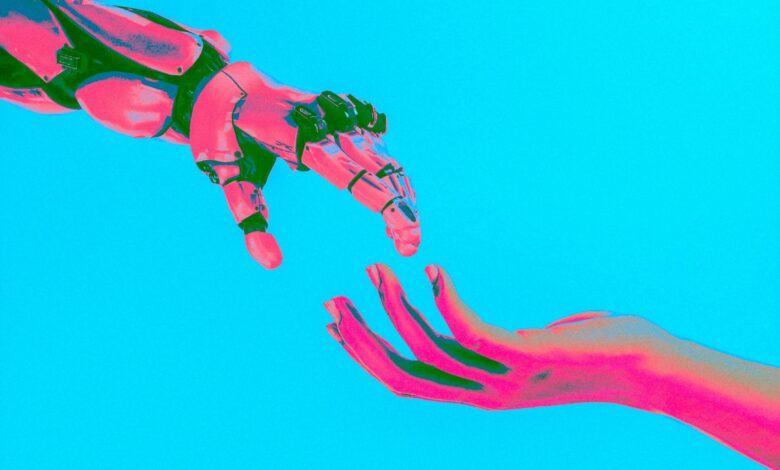
Artificial Intelligence, once a niche domain of computer science and speculative fiction, is now embedded in the systems that shape how societies operate. From diagnosing illness and optimising logistics to automating learning content and managing public services.
The key question is no longer whether to adopt AI, but how to use it in ways that serve human and planetary wellbeing. Technology itself does not determine our future. How we apply it, and the purposes we align it to, will shape the outcomes we experience.
In embedding AI within domains essential to humans flourishing, such as: healthcare, education, and civic society, the challenge is not simply to digitise existing processes, but instead to reimagine the goals and structures of these systems. When aligned with a clear and compelling vision, AI can become the enabling force that helps societies shift from fragmentation to integration, and from short-term performance to long-term flourishing.
Healthcare: Moving from Sick care to Holistic Wellbeing
Most health systems today operate in what we might call Horizon 1. This is the dominant paradigm that shapes current institutions, mindsets, and behaviours. It is characterised by fragmentation, reactive service delivery, transactional metrics and care models, and a short-term focus on symptoms rather than causes.
Within this horizon, AI has already brought important efficiencies. Predictive models are helping clinicians anticipate length of a hospital stay, improving discharge planning and resource allocation. During the COVID-19 pandemic, India’s Aarogya Setu platform used AI to trace contact and manage public health risk across vast populations. And in enhancing biomedical research capabilities tools like DeepMind have been successful in predicting protein structures with extraordinary precision – providing a route forward to greater scientific discovery.
However, these innovations, while valuable, are largely operating within the limitations of Horizon 1. A growing awareness is emerging across healthcare systems that if we keep doing what we are doing, we will keep getting what we’ve always had. The trajectory is clear. Rising demand driven by ageing populations, increasing chronic disease, and the high cost of new medicines and technologies is outpacing what this paradigm can sustainably deliver.
This is where Horizon 3 becomes essential. It is not merely a future state, but a shift in consciousness. It asks us to start with the first principle: what is health? What does a flourishing life look like across a “cells to cities” continuum? And what kind of system would we design if we began with a holistic view of health that included physical, mental, social, and environmental wellbeing?
In this vision, a 21st-century health system is no longer centred solely on treating illness. It becomes a collaborative ecosystem for wellbeing, enabling people to live with dignity, agency, and support throughout the course of their life. It is personalised, preventative, and participatory. It is enabled by technology but rooted in relationships.
Between Horizon 1 and Horizon 3 lies Horizon 2. This is the space of reimagination and transformation, where deeper insights into the human experience are explored and new approaches are created prototyped, tested, and refined through collaboration. It is not a linear transition, but a dynamic, messy process that involves deep learning, experimentation and cross-boundary partnerships.
AI can serve as a key enabler across all three horizons. In Horizon 1, it improves efficiency. In Horizon 2, it supports transformation by identifying patterns, accelerating learning, and enabling systemic collaboration. And in Horizon 3, it becomes part of a redesigned ecosystem in which care is decentralised, predictive and co-created with citizens.
And in enabling AI to bring these together, we must also invest in developing the human skills, perspectives and disciplines of those operating across the healthcare sector to guide the technology and drive effective transformation. Business and executive education providers can be an effective route for training health leaders to work across these horizons, complimenting their in-depth industry knowledge by building tailored business and technological skills along with the human leadership acumen to funnel it into the right areas and uses.
By doing this, AI is no longer simply a digital tool. It becomes part of a much larger shift, one that invites us to move from silos to systems, and transform individual services into deeper relationships that support lifelong health and human dignity.
Education: Cultivating Whole-Person Intelligence
Education systems around the world are under similar strain. Designed largely for the industrial era, they continue to focus on standardisation, performance metrics and content transmission. However, as the world becomes more complex and uncertain, the real need for students is not just for knowledge acquisition, but for enhancing adaptive capacity, moral judgement, creativity, and collaboration.
AI has already entered classrooms in powerful ways. Platforms like Khanmigo offer personalised learning paths that adapt to student needs. In underserved areas, AI tutors provide basic instruction where human teachers are unavailable.
These applications, like in healthcare, only offer short-term gains. The risk is that AI will be used merely to accelerate or enhance access to outdated educational paradigms. If we are not careful, we will use intelligent systems to reinforce narrow definitions of success and attention-hacking engagement strategies that undermine deep learning.
The opportunity, instead, is to reconsider what education is really for. In a world facing climate breakdown, technological disruption, and social polarisation, education must become a space for nurturing wisdom and human maturity in order to cultivate the skills and disciplines to create effective solutions. It must help people develop not just cognitive skills, but emotional resilience, ethical awareness, and the capacity to contribute to a shared future.
AI can support this broader purpose if it is designed and deployed with intention. It can help teachers identify learning needs early, create more inclusive environments, and support differentiated instructions. It can also enable peer-to-peer learning communities that bridge geographies and cultures.
The aim is not to replace teachers, but to amplify their capacity to facilitate meaningful growth in diverse learners. This shift will require more than good software. New governance models, co-designing with educators, and a shift in how we evaluate what counts as learning will all be vital.
As the pace of change accelerates, education can no longer be confined to childhood or early adulthood. We are entering an era where multiple career transitions across a lifetime will become the norm, requiring individuals to continually update their knowledge, skills, and mindsets. This calls for a radical rethink of further education, vocational training, and adult learning systems.
AI has the potential to personalise lifelong learning journeys, identifying skill gaps in real time and curating content suited to individual needs, contexts, and aspirations. It can also enable more equitable access to reskilling opportunities for those displaced by automation or shifting labour markets.
To be truly transformative, these systems must not simply focus on employability metrics. They should also nurture deeper capacities for adaptability, critical thinking, and civic contribution, ensuring that lifelong learning serves not only economic survival but also personal growth and societal resilience.
Just as in healthcare, AI in education must move from narrow optimisation to holistic transformation. That requires beginning with a clear vision of human development and designing systems around that aspiration.
Civic Society: Designing for Participation and Purpose
In civic society is where we are seeing the most promising potential for future-focused thinking. Thought leaders such as Indy Johar have argued that civic institutions must be redesigned to support complexity, pluralism, and interdependence. AI has a role to play in that redesign, but only if the systems are built with shared values, not just technical efficiency.
This means embedding transparency, accountability, and public deliberation into how AI is governed. It also means treating AI not just as a technology, but as infrastructure that should serve the common good. Civic AI must be designed with citizens, not just for them.
Algorithms now influence public services, urban planning, legal systems, and even democratic processes. Used well, AI can help governments become more responsive, transparent, and effective. Used poorly, it can entrench the capacity for surveillance, bias, and exclusion.
Some cities are showing what is possible. In Helsinki, AI is being used to model urban futures with citizen input. In Brazil, participatory budgeting is being augmented with machine learning to better reflect community priorities. In Jakarta, predictive models support climate adaptation by integrating local knowledge into infrastructure design.
These are Horizon 2 examples — transitional efforts to make governance more participatory, data-informed, and inclusive. They reflect a desire to move beyond top-down authority to collaborative problem-solving, creating better services and circumstances for society to benefit from.
The Leadership Imperative
The shifts described in this article are not only about adopting new technologies. They require a deeper reorientation of how leaders think, relate, and act. In times of rapid change, leaders must become adept in navigating the tension between current demands and future possibilities, becoming stewards of such transformations. This includes systems thinking, ethical foresight, and the ability to work across silos and time horizons. In accomplishing this, pursuing further training beyond the walls of industry with higher and executive education providers, and continuing to do so through a culture of lifelong learning is vital.
True leadership in the age of AI is not about controlling complexity. It is about cultivating the collective intelligence required to meet it with wisdom. It is about aligning innovation with what really matters and enabling others to do the same.
Choosing Our Direction
AI is here. Its influence will continue to grow. But the direction it takes will be shaped by human choices, values, and imagination.
This is not just a technological inflection point. It is a civilisational one. We must decide whether we use AI to reinforce outdated paradigms or to enable the emergence of systems that serve life more fully.
The future is not predetermined. It is something we can choose and design — together.





